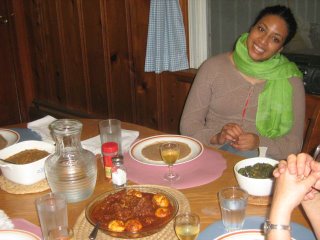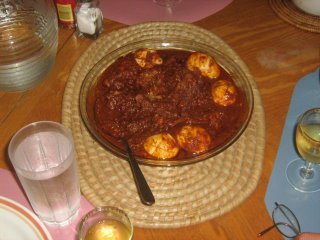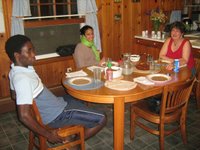Recipes for Doro Wat, Gomen Wat, and Kik
 Here are those recipes (courtesy of Laura Litwiller) for some of the dishes in our injera (Ethiopian flabread) videos (See last few blog postings).
Here are those recipes (courtesy of Laura Litwiller) for some of the dishes in our injera (Ethiopian flabread) videos (See last few blog postings).Chicken (Doro) Wat
Remove skin from about 2 pounds of chicken pieces (We used Cornish game hens. Traditionally a whole chicken would be cut into 8 pieces). Sprinkle with 2 Tablespoons (T) of lemon juice and 1 teaspoon (t) of salt. Let stand while preparing other ingredients.
Heat 4 T vegetable oil.
Add, cover and cook on low heat until onions are just browned: 2 cups (c) finely chopped onions, 1 T minced garlic, 1 t ginger root grated (or 1/2 t ground dried ginger).
Add: 1/4 t fenugreek, crushed, 1/2 t ground cardamom (Ethiopian, if available), 1/8 t ground nutmeg.
Stir well and add: 2 T berbere (for a mild wat) and 4 T paprika (for a hotter stew, use 4 T berbere and 2 T paprika),
2 T tomato paste, and 1 c water (or more, as needed).

Bring all ingredients to a boil and cook slowly, stirring often, for about 45 minutes. The sauce should be the consistency of heavy cream. Add a small amount of water if necessary.
Add the chicken pieces to the sauce, turning the pieces to coat. Add 2 T butter (Ethiopian spiced clarified butter, niter kibbeh, if available). Lower the heat and cook chicken for about an hour, turning the chicken often to prevent sticking and so it cooks evenly.
Prepare 1 hard-boiled egg for each person. Peel the eggs, and cut about 5 shallow slits in them to allow the wat to permeate the eggs. Add to the sauce the last 10 minutes of cooking time, gently stirring them into the stew to coat them.
Serve with injera.
Ethiopian Greens (Gomen Wat)
(Note: We made this with kale on the video, but I made it this week with some Swiss chard and it was also delicious).1 pound of green kale, chopped fine
1 medium onion finely minced
1/2 - 1 t chopped garlic
1/2 t ground ginger
1/2 t turmeric
1/2 t salt (or to taste)
1/2 t black pepper
1 jalapeno pepper, chopped (or to taste)
1/4 c vegetable oil
Saute onion in oil till clear, add garlic and spices and cook 3 minutes, add chopped kale and 1/2 c water. Cover and cook kale until tender (about 30 minutes). Add jalapenos and cook 5 minutes on low heat. Add more salt to taste (serves 6).
Serve with injera.
1 medium onion finely minced
1/2 - 1 t chopped garlic
1/2 t ground ginger
1/2 t turmeric
1/2 t salt (or to taste)
1/2 t black pepper
1 jalapeno pepper, chopped (or to taste)
1/4 c vegetable oil
Saute onion in oil till clear, add garlic and spices and cook 3 minutes, add chopped kale and 1/2 c water. Cover and cook kale until tender (about 30 minutes). Add jalapenos and cook 5 minutes on low heat. Add more salt to taste (serves 6).
Serve with injera.
Kik Pea Alecha (chick peas/garbanzo beans stew)
1 1/2 c minced onions
1/4 c vegetale oil
2 c cooked chick peas (garbanzo beans)
1/2 t turmeric
1/2 t fresh chopped garlic (or 1/2 t garlic powder)
1/2 t chopped ginger (or 1/4 t ginger powder)
Cook onions in oil until onions are clear. Add chick peas, turmeric, and 1 1/2 - 2 c water.
Cook for 20 minutes.
Add garlic and ginger. Cook until soft. Mash (or use blender or food processor to process until smooth).
Serve hot with injera.
My first attempt after the video to make the injera on my own was a disaster. I bought an inexpensive electric skillet, but it was not heavy enough to provide an even heat, and also it had an inaccurate thermostat, so part of the injera was burned, and part was not cooked. Plus I made the batter too thick. I tried again on the weekend. The first time I used my favorite cast iron pan, which made a lovely injera, but it stuck to the pan when I tried to take it out. Secondly I tried using a small nonstick pan on the stovetop, and added a little extra water to the batter when I added the self-rising flour, and everything was perfect. The only problem was it took me forever to finish making the injera because my pan was so small. I guess I'll either buy an electric mitad (the official injera-making pan) or a larger nonstick skillet. By the way, I made sure the skillet was completely grease-free when I used it. I scrubbed it with salt before cooking the injera, and each time after making an injera, I wiped the pan with a paper towel to clean it.
 Good luck. If you try this, let me know how it works for you. By the way, that's my daughter Masi (home from New York for the weekend) and Sam, my nephew/son and a junior at Penn State at the table with me.
Good luck. If you try this, let me know how it works for you. By the way, that's my daughter Masi (home from New York for the weekend) and Sam, my nephew/son and a junior at Penn State at the table with me.
1/4 c vegetale oil
2 c cooked chick peas (garbanzo beans)
1/2 t turmeric
1/2 t fresh chopped garlic (or 1/2 t garlic powder)
1/2 t chopped ginger (or 1/4 t ginger powder)
Cook onions in oil until onions are clear. Add chick peas, turmeric, and 1 1/2 - 2 c water.
Cook for 20 minutes.
Add garlic and ginger. Cook until soft. Mash (or use blender or food processor to process until smooth).
Serve hot with injera.
My first attempt after the video to make the injera on my own was a disaster. I bought an inexpensive electric skillet, but it was not heavy enough to provide an even heat, and also it had an inaccurate thermostat, so part of the injera was burned, and part was not cooked. Plus I made the batter too thick. I tried again on the weekend. The first time I used my favorite cast iron pan, which made a lovely injera, but it stuck to the pan when I tried to take it out. Secondly I tried using a small nonstick pan on the stovetop, and added a little extra water to the batter when I added the self-rising flour, and everything was perfect. The only problem was it took me forever to finish making the injera because my pan was so small. I guess I'll either buy an electric mitad (the official injera-making pan) or a larger nonstick skillet. By the way, I made sure the skillet was completely grease-free when I used it. I scrubbed it with salt before cooking the injera, and each time after making an injera, I wiped the pan with a paper towel to clean it.
 Good luck. If you try this, let me know how it works for you. By the way, that's my daughter Masi (home from New York for the weekend) and Sam, my nephew/son and a junior at Penn State at the table with me.
Good luck. If you try this, let me know how it works for you. By the way, that's my daughter Masi (home from New York for the weekend) and Sam, my nephew/son and a junior at Penn State at the table with me.Labels: doro wat, Ethiopian food, ethiopian greens, gomen wat, injera, kik, litwiller, watt

